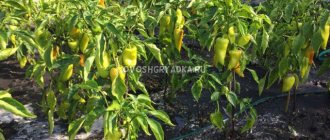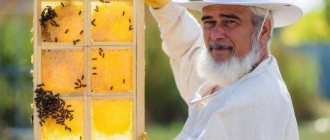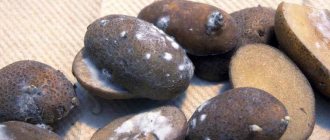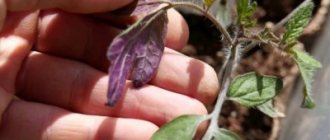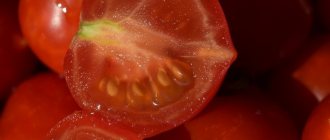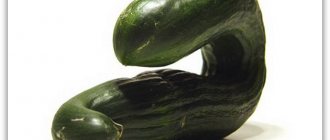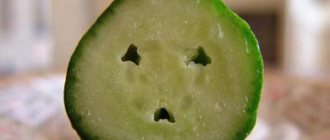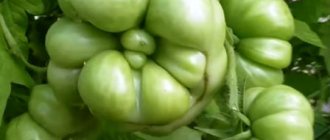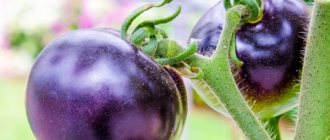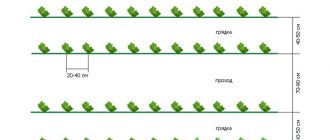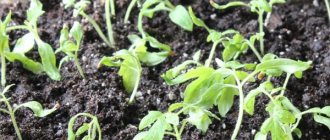Why don't potatoes bloom and how long does it take?
The peculiarities of the development of a potato bush are that the presence and number of flowers does not in any way affect the quality of the tubers. The way potatoes bloom profusely will not affect the harvest in any way.
But it is also prohibited to remove flower stalks. Because this injures the stems. Therefore, the potato will spend energy on recovery. This means that the tubers will stop growing at this time. Moreover, this is a proven fact. Many experiments have been conducted that have shown that removing potato flowers does not improve the quality of the crop.
To cut off or not
This question is often asked by beginning gardeners. Some agronomists believe that it is necessary to pick off potato flowers. This will increase productivity. According to others, the process depends on a large number of factors simultaneously.
The harvest is affected by:
- Air and ground temperature.
- Watering mode.
- Landing dates.
- Potato variety.
- Geographical conditions and climate.
- Length of daylight hours.
If circumstances are unfavorable, you may be left without a potato harvest. Whether the flowers will be torn off does not matter. Scientists from various regions conducted experiments and did not come to a consensus. In some cases, when flowers were removed, the yield increased by 25%, and in others only by 3%. Since the cutting process takes a lot of time, summer residents must decide for themselves whether to carry it out on their site or not.
Why potatoes don’t bloom - a feature of the variety
Sometimes, the flowers are so small and bloom for a very short time. Therefore, for summer residents, the flowering time remains unnoticeable.
If ultra-early potatoes are planted on the site, they may not bloom at all. This is due to the fact that root crops are formed completely separately from the budding period. Therefore, breeders ensured that the plant did not waste energy on an unnecessary process. Examples of such varieties are Roko, Empress, Mariella and Timo.
There are also potato varieties that bloom depending on the weather. For example, “Spring” blooms at normal humidity, but very quickly. And in a season that is characterized as dry, the plant refuses to bloom.
Effect of flowering on yield
The issue of potato flowering is not strategically important. Flowering is not directly related to the formation and development of potato tubers. For some varieties, flowering is a sign of the beginning of tuber formation and fertilizing will come in handy.
You should know that flowering directly depends on the potato variety. Thus, early varieties are characterized by a lack of flowering. This is the achievement of breeders. They developed varieties of potatoes that do not bloom. At the same time, all efforts are aimed at obtaining healthy, high-quality tubers, and are not spent on flowering. These varieties produce tubers early. The absence of flowering in the life cycle helps to avoid pest damage and disease.
Some varieties have fast, lightning-fast flowering. If you rarely visit the garden, you may not notice it.
There are potato varieties that, depending on weather conditions, decide for themselves whether to bloom or not. So in dry weather, they may not bloom, so as not to waste energy on it.
It is necessary to pay attention to the conditions for growing potatoes, so that the bushes have enough light and moisture, so that they receive nutrition and are healthy. When purchasing planting material, you need to clarify whether a given variety should bloom.
Source
Why potatoes don't bloom: pests and care
- Ground beetles and potato ladybugs. They do not cause significant harm, but there is no benefit from them either. During potato flowering, adult individuals of these beetles begin to actively eat flower stalks. If there are a lot of insects, they will destroy the buds so quickly that flowering will not begin.
- Potato planting site. In a heavily shaded area of the garden, some plants may bloom, while the rest will remain without buds.
- Excessive use of nitrogen-containing fertilizers. Then the potato bush will actively grow and miss the flowering period.
- Heat. In this case, the plant will begin to shed flower stalks, preventing them from blooming. This can be understood by the general appearance of the potato bush. It will be weak, the stems will begin to dry out and will be small.
- Excess moisture.
- Poor soil.
Potato flowering: when and how long does the period last?
When potatoes bloom, there is no definite answer. It all depends on the starting point. If you count from the moment the tubers are planted in the ground, then it will take from 45 to 60 days until the first flowers appear. Sometimes gardeners are in a hurry to plant tubers in the ground. Planting is timed to coincide with holidays and weekends. Unwarmed soil inhibits seedlings. They appear a couple of weeks later.
If you count from the moment the first shoots appear, the potatoes begin to bloom after 3-4 weeks. The exact date cannot be determined. It all depends on the weather and the speed of plant growth. The seedlings grow unevenly. Some are moving up quickly, while others are lagging behind significantly. On strong shoots, flowers will appear earlier. Weaker seedlings will bloom later.
Do I need to do anything if the potatoes don't bloom?
First you need to make sure that the plant is not an ultra early variety, and the plant must bloom. Then it is necessary to eliminate the reasons that led to a decrease in the number of flowers.
It is clear that excessive moisture due to rain cannot be reduced. But you can cope with drought in a small garden bed near your dacha. To do this, you just need to water the potatoes regularly.
Pests will need to be treated with the appropriate chemical. And spray the plants with zircon. In addition, it is recommended to fertilize using complex fertilizer. Moreover, the last action is recommended to be carried out even if the potatoes develop according to all the rules.
Flowering and non-flowering varieties
People who are confused by the budding process can choose non-blooming potato varieties. The Timo and Empress varieties do not have this trait at all: they are not genetically predisposed to flowering. This group also includes early Mariella and Rocco, which ripen so early that they do not have time to open the buds.
Flowering potato varieties include Alvara, Nevsky, Golubizna, Gatchinsky, Nikulinsky, Druzhny, Istrinsky, Rosamunda, Erbitsky, Kamensky. Some of them bloom such beautiful bright flowers (blue, scarlet, purple) that the owners specially select this variety to decorate the garden. These are old types of potatoes that are most common in our country.
Separately, it is worth highlighting the potatoes Courier, Vyatka, Early Rose, Table 19: their flowering is influenced by weather, care and other factors.
Read also Duck goose breed photo
Natural reasons for lack of flowering
Breeders have developed varieties (usually early potatoes) that do not grow flowers. Tubers grow earlier and such potatoes are less susceptible to infection by fungal diseases and parasite attacks: all their strength is aimed at maintaining immunity.
Sometimes a farmer may not notice that potatoes are blooming if the phenomenon was short-lived and did not last too long. In addition, the flowers are small in size and therefore remain unnoticed.
Some varieties, if they lack moisture, decide not to waste extra effort. This is another weather explanation for why potatoes don't bloom.
If the stems of a plant begin to wither, it suffers from the heat.
Other reasons
Potato flowering depends on many factors
Other reasons for the lack of flowering on potatoes include:
- attack by insect pests such as ladybugs or ground beetles;
- planting fruits in the shade;
- choosing not too fertile soil for planting.
- overfeeding with nitrogen fertilizers.
- excessive watering.
Basically, the listed reasons are associated with the farmer’s mistakes. How global they turned out to be can be found out when it’s time to dig the garden.
The importance of flowering when growing potatoes
A month after planting the tubers, the first buds appear on the bushes. Friendly and active flowering for experienced summer residents is hope for a harvest. But this is a misconception. How potatoes bloom and how much is formed in the ground - these factors are not related to each other. Breeders are developing new varieties that do not form buds at all and bear fruit well.
Some gardeners remove flowers on old and proven varieties to increase yield. But this is prohibited. If you walk between the tuber bushes and pick flowers, the stems will be injured and the soil will be trampled. In a few days they will rise, but will spend their resources, which would participate in the formation of tubers. It has been experimentally proven that removing flower stalks does not lead to an increase in yield, and this is not necessary.
Read also: Pickled green tomatoes in slices for the winter
The beginning of plant flowering requires fertilizing. During the period of bud formation, the plantings need to be well treated with ash, and when they bloom, feed the tubers with an infusion of chicken manure. In dry weather, you need to water the plants at the rate of 3 liters of water per bush, but do not allow excess moisture. You should not focus on the flowering of the tops; this is only a factor in monitoring the readiness of the tubers.
Care during flowering
Budding accompanies active tuberous growth of potato fruits. This process should be supported by fertilizing. The first is introduced at the beginning of budding in order to speed it up. 3 tbsp. l.ash is mixed with 1 tsp. potassium sulfate per 1 m of bed. The next feeding (2 tablespoons of superphosphate) is carried out on the 5th day of flowering.
The method is root based. You can also try foliar feeding. For one hundred square meters per 10 liters of water take 50 g of potassium sulfate, 40 g of urea, 20 g of ammonium nitrate.
Protection from Colorado potato beetles during flowering is not easy. You cannot resort to chemicals. There are 2 options: destroy the parasites with your hands or use folk remedies.
An easy way is to sprinkle cornmeal on the bushes. You can also prepare a special product by boiling 10 liters of water with 1 kg of wood ash added there and 50 g of crushed laundry soap. It is recommended to use both products no more than once a week. In case of a mass attack, a biological preparation like Fitoverma is used.
The human factor intervened
Might be interesting Potatoes of the "Tuleevsky" variety - an excellent option for Siberia Let's grow potatoes "Gala" - a yellow and tasty variety Potatoes "White Rose": the best-seller among early varieties
Immediately after planting, the summer resident makes mistakes. First, the vegetable was placed in an area of constant shade. This cannot happen without effect, because the vegetable loves light. The second mistake is that the gardener gets carried away by applying fertilizers and nutrients too frequently. The future harvest may not bloom much because the gardener has “overfed” it. Before applying fertilizers, study the recommendations. They are written on the packaging with planting material.
You should not torment yourself with the question of whether those who do not follow the watering rules will have a good harvest. There should not be too much or too little liquid. As stated earlier, each variety requires a recommended watering schedule. The last reason, which is included in the list of the so-called human factor, is associated with the wrong choice of soil.
On a note!
The latter fact will slow down the flowering of planted potatoes, but will not destroy the future harvest. It is enough to drop a little near the plantings to see the formed tubers.
Tips and tricks
Experienced farmers have trimmed potato flower stalks on their plots more than once and share their recommendations:
- Before carrying out the procedure, prepare a disinfectant solution and periodically treat the blades with it to prevent the transmission of diseases and fungi through garden tools.
- Do not trim flower stalks in cold weather or during periods of high humidity - this will create favorable conditions for the development of late blight.
- In parallel with removing flowers, inspect the bushes for the presence of pests and diseases. Prepare a jar in advance to collect the Colorado potato beetle or its larvae - during the flowering period it often attacks potatoes.
